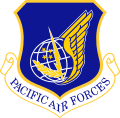14th Flying Training Wing | |
|---|---|
 Northrop T-38C formation from the 50th Flying Training Squadron [note 1] | |
| Active | 1947–1949; 1966–1971; 1972–present |
| Country | |
| Branch | |
| Role | Undergraduate Pilot Training (UPT) |
| Part of | Air Education and Training Command |
| Garrison/HQ | Columbus Air Force Base |
| Nickname(s) | Team Blaze |
| Motto(s) | "Cultivate Airman, Create Pilots and Connect" |
| Engagements | Vietnam War |
| Decorations | Presidential Unit Citation Air Force Meritorious Unit Award Air Force Outstanding Unit Award with Combat "V" Device Air Force Outstanding Unit Award Republic of Vietnam Gallantry Cross with Palm |
| Commanders | |
| Current commander | Col. James J. Blech |
| Deputy Commander | Col. Jonathan Cato |
| Command Chief | CMSgt Todd R. Rosenzweig |
| Notable commanders | Robert H. Foglesong |
| Insignia | |
| 14th Flying Training Wing emblem (approved 19 June 1967, restored 21 December 2007) [1] |  |
| 14th Flying Training Wing (approved 16 September 1994) [1] |  |
The 14th Flying Training Wing is a wing of the United States Air Force based out of Columbus Air Force Base, Mississippi.
Contents
- History
- Air Defense
- Vietnam War
- Flying training at Columbus
- Units
- Lineage
- Assignments
- Components
- Stations
- Aircraft
- References
- Notes
- Bibliography
- External links
The 14th Operations Group and its six squadrons are responsible for the 52-week Undergraduate Pilot Training (UPT) mission. The group also performs quality assurance for contract aircraft maintenance.
The 14th Mission Support Group provides essential services with a 5-squadron/2-division, 750+ person work force and $38 million budget. It operates/maintains facilities and infrastructure for a 6,013-acre (24.33 km2) pilot training base and provides contracting, law enforcement, supply, transportation, fire protection, communications, education, recreation and personnel management for 9,500 people. The group is also responsible for wartime preparedness and contingency operations.




